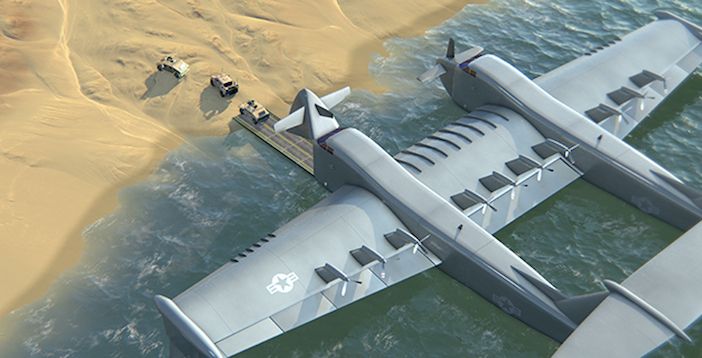Efforts to build the Liberty Lifter – an X-plane that demonstrates heavy-air-lift capability from the sea – are progressing toward a preliminary design.
Aurora Flight Sciences said it is progressing through Phase 1B of the project, a Defense Advanced Research Projects Agency (DARPA) program to design, build, float, and fly the aircraft.
To meet heavy-air-lift capability from the sea the vehicle will operate efficiently in ground effect at high sea states and demonstrate affordability using low-cost manufacturing and unique design features.
Virginia-headquartered Aurora Flight Sciences added that a major focus during Phase 1B is testing for risk reduction. ReconCraft, an Oregon-based shipyard, will build full-scale structural test articles, including a portion of the fuselage.
Phase 1B concludes with a preliminary design review, which is scheduled for January 2025. If the program progresses, flight testing would occur in 2028.
The Aurora team also tested a scale model of the hull in the tow tank at Virginia Tech, which offers the capability to study the slamming of craft during landing. Upcoming testing includes flying sensors and software for wave detection and prediction, which will feed the X-plane’s advanced control system for safely flying in ground effect over high sea states.
In its latest iteration, Aurora’s design for Liberty Lifter changed from a t-tail to a pi-tail, which is said to be more structurally efficient when accommodating an aft cargo door. Floats have been relocated from the side-sponsons to the vehicle’s wing tips, creating a better balance between vehicle affordability and performance in ground effect.
Along with ReconCraft, the Aurora-led team includes naval architecture and marine engineering company Gibbs & Cox. Advisors and engineers from Aurora’s parent company, Boeing, also bring their expertise to the team.
“Innovations often occur at intersections. Here, it’s the intersection of our maritime and aerospace teams,” Dan Campbell, Aurora program manager said. “For example, the intersection of maritime manufacturing with aerospace structural design, or the intersection of maritime wave forecasting with aerospace controls.”





